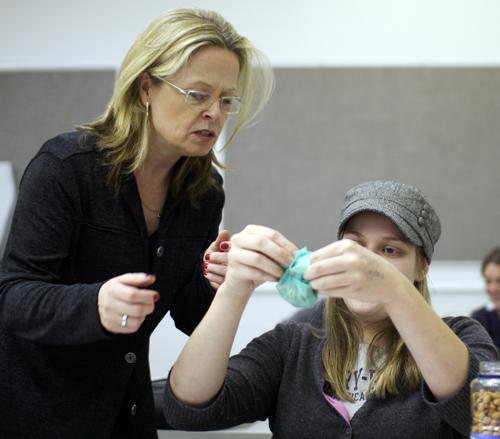Entrepreneurship expands across disciplines

Trevor Greene The Daily Illini Libby Phelps, right, senior in FAA, discusses with Dr. Deana McDonagh, associate professor of industrial design, how to redesign a dental dam to be used as a storage container for peanuts during a class at the Art and Design Building on Wednesday, Feb. 11, 2009. The class is designed as a way in which industrial design majors and gender and women’s studies majors can collaborate to design and redesign products to better suit women’s needs.
Feb 12, 2009
Last updated on May 13, 2016 at 08:00 p.m.
Around campus, art design majors are sitting down with gender and women’s studies majors to discuss technology and feminism. Elsewhere, engineers get in touch with their creative side while exploring the Krannert Art Museum. Around campus, classes designed towards ‘the spirit of entrepreneurship’ are experimenting with new content and collaboration.
In this case, the word entrepreneurship is not just referring to business, but rather a mind-set where students and faculty use what they learn from multiple disciplines and departments to solve problems.
Bruce Litchfield, assistant dean of Engineering, started teaching his class about creativity just last semester.
“I see this class as absolutely necessary,” Litchfield said, referring to courses required for Engineering students. “With all the problems in the world, we need engineering students to not only have skills in math, physics…but we need them to be creative in order to find new solutions.”
Get The Daily Illini in your inbox!
Litchfield was first inspired as an undergraduate at the University by a former professor who taught a class on creativity. Litchfield developed his own spin on the class when he came back years later as a professor. Funded by the Academy for Entrepreneurial Leadership, his course deals with “a little theory, and a lot of practice.” The course mainly deals with how one becomes more creative, and works to help students with the juxtaposing and collaboration of different ideas.
The Department of Gender and Women’s Studies is also seeing a change. Sharra Vostral, assistant professor of history, is piloting a course with Deana McDonagh, professor in industrial design. This course deals with women and technology and is called the Feminist Inventor Studio. Most of the students are design majors, with a substantial amount of Gender and Women’s Studies majors. The class meets in a studio setting, which Vostral said adds to the entrepreneurial aspect of the class.
“It’s different for humanities students to have to sit down in a studio and immediately draw during projects,” she said. “And for design students, it’s different for them to discuss the readings in a seminar style.”
Vostral’s course was also funded by a grant from the Academy and has changed the way she views entrepreneurship.
“Usually entrepreneurship is about business or under the control of the business school,” she said. “The way the grant was worded was about problem solving. It was exciting to me because my work relates to women and technology. With the entrepreneurial grant, this would be a cool way to go about making technology with women in mind.”
Vostral also works with iFoundry, a group seeking to revitalize engineering education. She said there is a need for more collaboration between all departments in the University.
“It’s not enough to stick to routine, so what happens if we change things a little?” she said. “We need humanities students who are technologically savvy. We need engineers who are versed in arts and humanities. The time has come for that, and entrepreneurship has been a way to get that collaboration going.”
Students aren’t the only ones learning creative thinking.
“Preparing for the course forced me to go back to school on a lot of this stuff – which is good,” said Kathryn Anthony, Professor of Architecture.
Anthony teaches a class on architecture and diversity, and said that she wanted to start the course as a way to help architecture students channel their creativity in different ways.
“Especially with this current economic depression, the students need to be able to use their skills for a variety of situations,” she said.
Anthony also hopes that despite this era of cutting back across campus, the University will continue to keep courses centered around the idea of entrepreneurship.
“It takes the faculty a lot of effort to prepare and move in a direction they’re not used to,” she said. “And it’s a good direction for the entire University to go. The University needs to support this effort and energy.”





